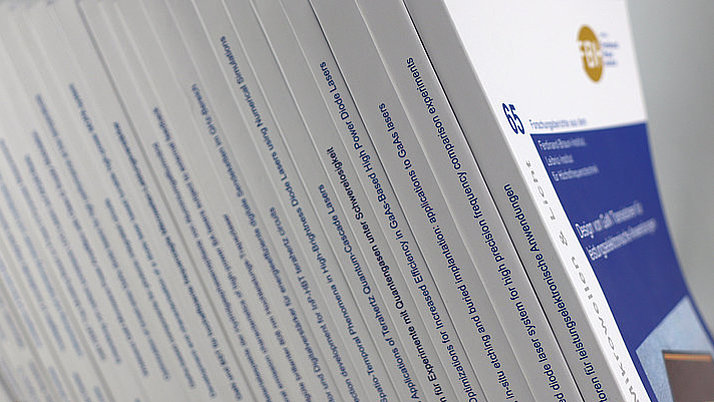Radiative Recombination and Carrier Injection Efficiencies in 265 nm Deep Ultraviolet Light-Emitting Diodes Grown on AlN/Sapphire Templates with Different Defect Densities
A. Muhin1, M. Guttmann1,2, V. Montag1, N. Susilo1, E. Ziffer1, L. Sulmoni1, S. Hagedorn2, N. Lobo-Ploch2, J. Rass2, L. Cancellara1, S. Wu1, T. Wernicke1, and M. Kneissl1
Published in:
phys. stat. sol. (a), vol. 220, no. 16, Special Issue: Nitride Semiconductors, pp. 2200458, doi:10.1002/pssa.202200458 (2023).
Abstract:
The electro-optical characteristics of deep ultraviolet light-emitting diodes (DUV LEDs) emitting at 265 nm and grown on AlN/sapphire templates with different threading dislocation densities, i.e., high-temperature annealed (HTA) AlN, epitaxially laterally overgrown (ELO) AlN, and HTA-ELO AlN are analyzed. The external quantum efficiency of each individual device is separated into maximum radiative recombination efficiency, carrier injection efficiency, and light extraction efficiency. This is achieved by combining an ABC-model-based fit of the current-dependent external quantum efficiency together with calibrated Monte Carlo ray-tracing simulations. A maximum radiative recombination efficiency between 50% and 60% is estimated for DUV LEDs grown on ELO and HTA-ELO AlN/sapphire, whereas the values for devices grown on HTA AlN/sapphire are around 45%. The extracted radiative recombination efficiency does not scale with the measured threading dislocation density (TDD), even when accounting for the inhomogeneous TDD in the AlN base layers. This discrepancy is attributed to the formation of dislocation half-loops introduced by additional compressive strain caused by the HTA process and may result in the formation of additional nonradiative recombination centers in the AlGaN multi-quantum well region. In addition, the carrier injection efficiency values ranging from 45% to 55% are determined for devices grown on all three templates.
1 Institute of Solid State Physics, Technische Universität Berlin, Hardenbergstraße 36, 10623 Berlin, Germany
2 Ferdinand-Braun-Institut (FBH), Gustav-Kirchhoff-Straße 4, D-12489 Berlin, Germany
Keywords:
carrier injection efficiency, epitaxial lateral overgrowths, high-temperature annealing, misfit dislocation, radiative recombination efficiency, threading dislocation density, UVC
© 2023 The Author(s). Published on behalf of The Japan Society of Applied Physics by IOP Publishing Ltd
Content from this work may be used under the terms of the Creative Commons Attribution 4.0 license. Any further distribution of this work must maintain attribution to the author(s) and the title of the work, journal citation and DOI.
Full version in pdf-format.


